I always thought the aluminum bialetti left a metallic taste in its brew so my Lady and I switched our morning ritual to a stainless model over a year ago and never looked back. I’ve heard, and read, of others who felt and did the same, yet there’s always been that little nagging modern doubt: did you compare the two scientifically?
I had a few minutes free this afternoon while my computer force-restarted for another OS update so I pulled out the old aluminum Bialetti for a head-to-head showdown with its stainless steel cousin. I’m going to test a theory I’ve been kicking around:
Does a stainless steel Bialetti make better coffee than an aluminum one? Could the entire nation of Italy be wrong in using the ubiquitous aluminum moka pot, or is metal poisoning so prevalent and culturally entrenched (this would explain a lot about Italians) that they’re blind to the taste superiority (and the intuitively-but-unproven “It MUST be healthier”) benefits of stainless?
The following experiment is a fairly typical and applicable one for the masses: we’re using generic medium roast grocery-store beans, tap water, and a blade grinder, i.e. the way most people in North America use a Bialetti. Variables across platforms were minimized as much as possible. Same coffee, same grind, same water, same temperatures. Same electric stove, pre-boiled kettle, and mugs. Both Bialetti’s are a few years old, gently used, well-seasoned, with good seals. The only difference is the models themselves.*
Bonus: this article can also serve as a general how-to guide for the Bialetti coffee-brewing steps and process.
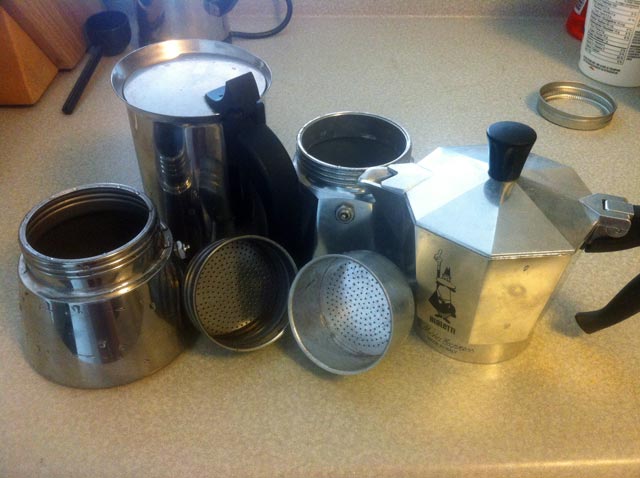
The contenders, baskets and all: a Bialetti Venus (stainless, on left) and regular Moka Express (aluminum, on right). Note the baskets are stainless and aluminum, respectively.

Side-by-side comparison of the stainless (left) and aluminum (right) baskets. The aluminum is slightly larger.
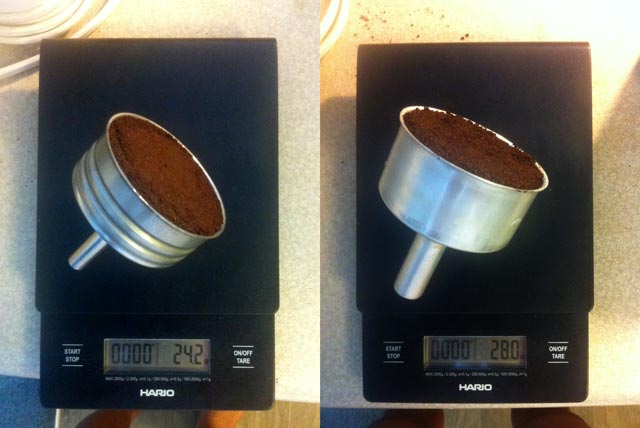
How much larger? Using my regular ‘lightly-spooned and evenly-distributed and tamped as possible with a coffee spoon” method, the stainless basket held ~24 grams of ground coffee to the aluminum’s 28 grams. Both refer to net weight of the grounds, after taring the weight of the baskets.
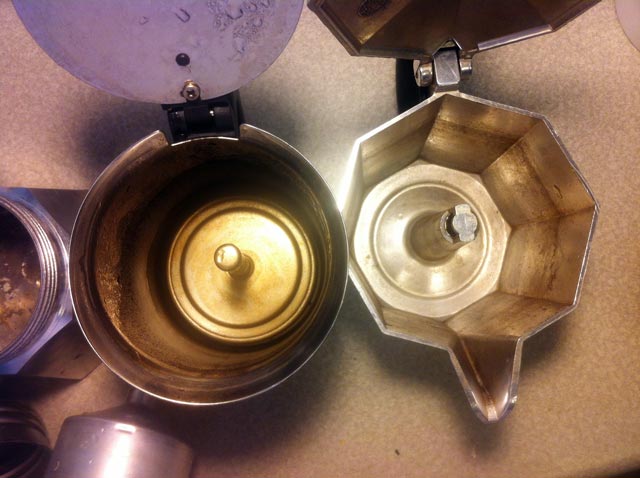
Fairly seasoned. Both were pre-rinsed and warmed with boiling water while the grounds and baskets were prepped.
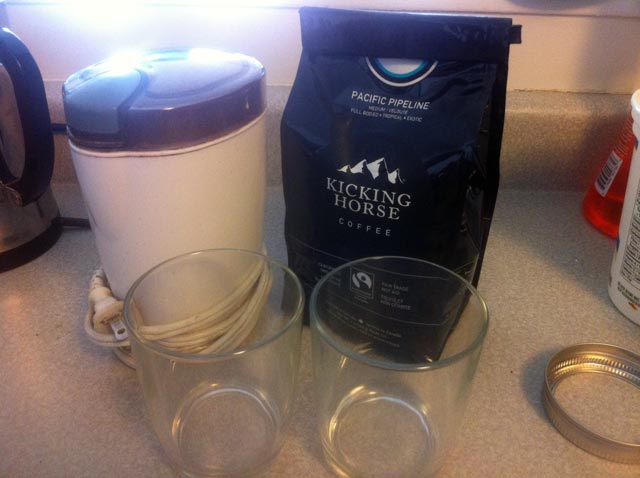
Typical blade grinder, pre-warmed glasses (mini Nutella jars!) and a nicer brand of grocery store medium-roast beans (Kicking Horse coffee out of Invermere, British Columbia, Canada). Beans for both were ground for ~10 seconds, one batch per pot.

Vancouver tap water boiled for pre-warming receptacles, and for final brew.
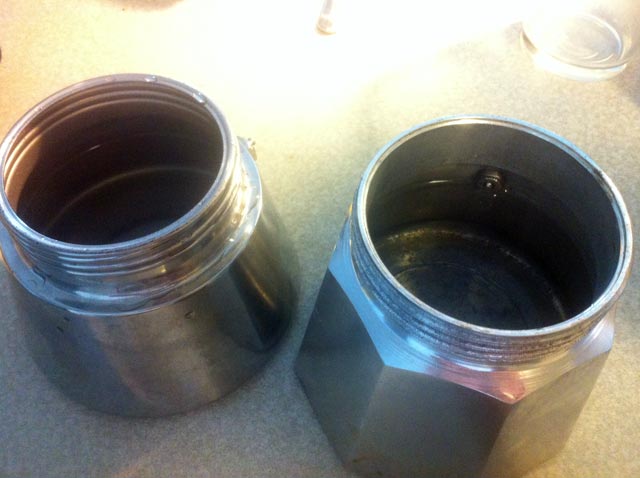
Pre-boiled water filled to the miniscus edge of each Bialetti’s reservoir safety valve.

Burners set to ‘9’ (one down from ‘Max’; though I wish my stove went to ‘11’). Note both pots were set on the same sized burners, at the same time, in the same positions.
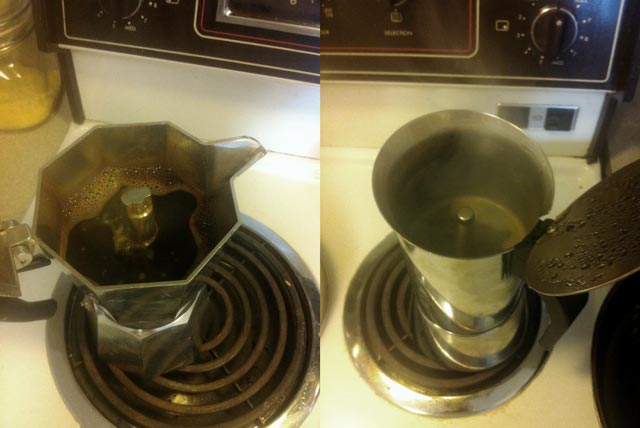
Brewing: the nicest step in the moka pot process.
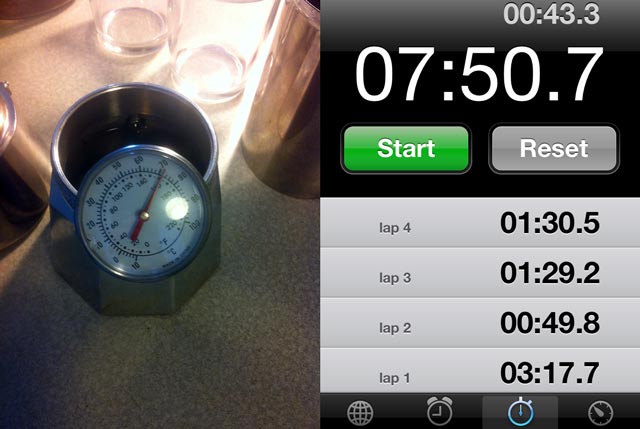
Temperatures and time: by the time grinding and loading was finished both reservoirs had cooled to ~70ºC / 160ºF. Timing on the right is for actual percolation / brew times. Both pots were removed when they began to spurt and make the distinctive ‘gurgling / wooshing’ Bialetti sound. Lap 1 is the time in which the stainless completed its percolation. Lap 2—forty-nine seconds later—is when the aluminum spurted its last drops. Lap 3: both were allowed to sit and ‘set’ for another minute-and-a-half (though the stainless had an extra plus 49 seconds) before pouring. Lap 4: I let another 1:30 elapse for cooling and setting in the glasses before tasting. Please note: normally I’d pull a Bialetti off the burner prior to the spurts (I usually pre-empt it when it’s about 2/3-3/4 through to the final brewing volume in order to avoid the theoretical over-heating and burning of the grounds—another experiment for another day). For the purposes of comparing the two it was more fair to let them sit until they’re damn well ready to come off the stove than try to guess where the near-to-done point is.

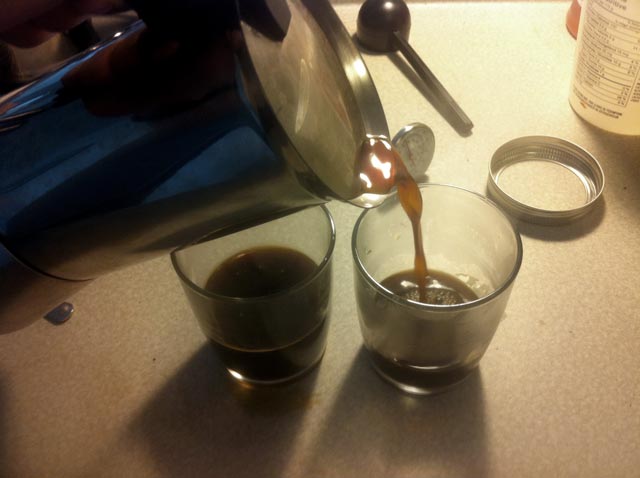
The pour: the second-best part of the process.†


Colouring and tone: to my eyes and the iPhone camera’s, both had the same colouring, tone, density. Aluminum on left, stainless on right.
Conclusion
Wow, they both smell and taste metallic and they both make sub par coffee. Maybe I’ve always psychosomatic-sized the stainless into tasting better?
Unlike most early studies with small sample sizes (uhm, in this case one sample) this doesn’t warrant further research. Just buy better beans and use an Aeropress or pourover.
But if you MUST use a mokapot, I guess use the stainless to drink from (it maybe tasted slightly—very slightly—less metallic, or at least a slightly different metallic taste) and just have your unused aluminum one on display because it looks classier and old school and Italian.

In the end I can never really stomach a Bialetti brew and add sugar anyways.
*OK, there are a few flaws in my otherwise rigorous scientific method. For one I spent 10 minutes on the whole thing, in my underwear. The more ‘scientific’ among you could also point out that the stainless Bialetti uses a slightly smaller basket; my aluminum’s a bit larger capacity. And that the grounds for the stainless had an extra minute or two of off-gassing while I pulverized and loaded the aluminum’s beans and basket. Plus I knew which cup had which Bialetti’s brew. Whatever.
† Actually, the best part of making coffee this way is the smell of a fresh grind (even if it is a blade grind), THEN watching the brew in action, THEN the pour.
Leave a Reply